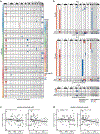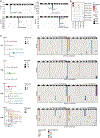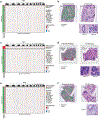Normal breast tissues harbour rare populations of aneuploid epithelial cells
- PMID: 39567687
- PMCID: PMC12367288
- DOI: 10.1038/s41586-024-08129-x
Normal breast tissues harbour rare populations of aneuploid epithelial cells
Abstract
Aneuploid epithelial cells are common in breast cancer1,2; however, their presence in normal breast tissues is not well understood. To address this question, we applied single-cell DNA sequencing to profile copy number alterations in 83,206 epithelial cells from the breast tissues of 49 healthy women, and we applied single-cell DNA and assay for transposase-accessible chromatin sequencing co-assays to the samples of 19 women. Our data show that all women harboured rare aneuploid epithelial cells (median 3.19%) that increased with age. Many aneuploid epithelial cells (median 82.22%) in normal breast tissues underwent clonal expansions and harboured copy number alterations reminiscent of invasive breast cancers (gains of 1q; losses of 10q, 16q and 22q). Co-assay profiling showed that the aneuploid cells were mainly associated with the two luminal epithelial lineages, and spatial mapping showed that they localized in ductal and lobular structures with normal histopathology. Collectively, these data show that even healthy women have clonal expansions of rare aneuploid epithelial cells in their breast tissues.
© 2024. The Author(s), under exclusive licence to Springer Nature Limited.
Conflict of interest statement
Competing interests: The authors declare no competing interests.
Figures













References
-
- Curtis C et al. The genomic and transcriptomic architecture of 2,000 breast tumours reveals novel subgroups. Nature (2012). https://doi.org:nature10983 [pii] 10.1038/nature10983 - DOI - PMC - PubMed
MeSH terms
Substances
Grants and funding
LinkOut - more resources
Full Text Sources

